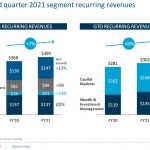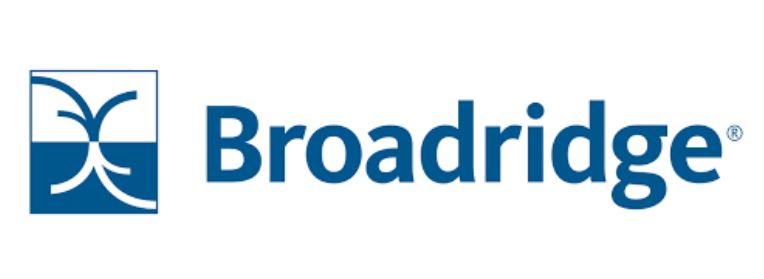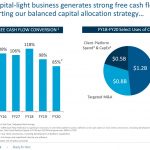Contents
Broadridge Financial Solutions, Inc. (BR) is a capital light business in which ~65% of its revenue is recurring. It has a track record of generating strong Free Cash Flow (FCF) although the second half of the fiscal year is when BR generates the bulk of its annual FCF.
Summary
- Broadridge has a dominant market share position in the delivery of proxies and interims to beneficial shareholders.
- The investor communication solutions and global technology and operations businesses are sticky, with retention rates near 98%.
- Recurring revenue is ~65% of total revenue.
- BR operates a capital light business which has resulted in a strong Free Cash Flow (FCF) track record although FCF is generally weak the first half of each fiscal year.
- A BR investor will most likely generate the bulk of their long-term investment return from capital appreciation which makes it that much important that shares be acquired at a reasonable valuation.
- Based on FY2021 guidance provided by management when Q2 2021 results were released at the beginning of February, I would require a ~20% share price pullback in order to add to my existing position.
Introduction
I last briefly analyzed Broadridge Financial Solutions, Inc. (BR) in this article. In that article I disclosed a share price pullback had brought BR shares to a reasonable valuation and I decided to acquire additional shares.
I then disclosed in my FFJ Portfolio – March 2020 Interim Report published March 15, 2020 that with the broad market pullback I took the opportunity to acquire shares in high quality companies that had suddenly become attractively valued. Included amongst these purchases was the acquisition of a few more BR shares @ $100.1658/share.
Subsequent to my March 2020 article, BR has completed FY2020 and on February 2, 2021 it released Q2 2021 results. I now take this opportunity to briefly look at BR to determine whether this might be an opportune time to acquire additional shares.
Business Overview
BR was once part of Automatic Data Processing, Inc. (ADP) but was spun off as a separate publicly traded entity in March 2007; as an ADP shareholder I ended up receiving BR shares.
If you are unfamiliar with BR I highly recommend you:
- read Item 1. Business (starts on page 27 of 145) in the 2020 10-K which is included with the 2020 Annual Report;
- review BR’s Investor Presentation which was uploaded to the company’s site on December 16, 2020. This presentation provides the strategy for BR’s two business segments (Investor Communication Solutions and Global Technology & Operations) as well as an overview of the company’s financial model that is focused on driving steady revenue growth and consistent EPS growth.
Q2 and YTD2021 Results and FY2021 Guidance
BR’s Q2 2021 and YTD results as at December 31, 2020 can be found here and the accompanying Earnings Presentation can be found here.
One of BR’s objectives is to increase the extent to which it generates recurring revenue. We see that BR continues to make progress in this regard.
 Source: BR Q 2 2021 Earnings Presentation
Source: BR Q 2 2021 Earnings Presentation
Free Cash Flow (FCF)
BR has only generated $32.5 million in FCF in the first 6 months of FY2021 which is calculated by taking $83 million of net cash flows provided by operating activities minus $30.1 million of capital expenditures and $20.7 million of software purchases and capitalized internal use software (refer page 7 of 63 in the Q2 10-Q). This excess FCF enabled BR to make a net debt repayment of $27.8 million (the difference between debt proceeds and debt repayments).
Looking at the first 6 months of the previous fiscal year we see that BR generated negative FCF of $31.5 calculated by taking $11.5 million of net cash flows provided by operating activities minus $31.6 million of capital expenditures and $11.4 million of software purchases and capitalized internal use software. This shortfall was covered by debt proceeds being $384.3 million higher than debt repayments; some of this additional debt went toward the Fi360, Inc. (‘Fi360’) acquisition. Fi360 is a provider of fiduciary and Securities and Exchange Commission Regulation Best Interest solutions for the wealth and retirement industry. The purpose of this acqusition was to enhance BR’s retirement solutions by providing wealth and retirement advisors with fiduciary tools that complement BR’s Matrix trust and trading platform.
BR typically generates negative FCF in the first half of the fiscal year but ends up with strong FCF by the end of the fiscal year. You can see this on page 88 of 145 in the 2020 Annual Report/10-K. In fact, BR generated annual FCF (in millions) of 167, 238, 220, 334, 365, 362, 312, 556, 544, and 500 in FY2011 – FY2020. NOTE: you have to account for the purchase of intellectual property in FY2017 and FY2018.
Source: BR Investor Presentation – December 10, 2020
Credit Ratings
All 3 major ratings agencies rate BR’s senior unsecured long-term debt as the top tier of the lower medium grade category. This is investment grade and meets my risk tolerance.
- Baa1 (Moody’s) which is the top tier within the upper medium grade category;
- BBB+ (S&P) which is the lowest tier within the high grade category;
- BBB+ (Fitch) which is the top tier within the upper medium grade category.
BR’s dividend history can be found here.
In early January, BR distributed its second $0.575 quarterly dividend and on February 12, 2021 the 3rd consecutive quarterly dividend at this level was declared. I anticipate the 4th $0.575 dividend to be distributed in July and envision BR’s Board of Directors will authorize a ~6% dividend increase ($0.035/share/quarter) to $0.61/share/quarter commencing with the October dividend.
On the basis of the current ~$148 share price, the current dividend yield is ~1.55%. If my anticipated dividend increase does materialize then we have 2 more $0.575 quarterly dividend payments and 2 at $0.61 for a total of $2.37 which results in a forward dividend yield of ~1.6% based on the current share price. This is somewhat lower than when I wrote my previous articles but investors would be wise to view the potential long-term return from BR as most likely to come from capital appreciation as opposed to dividend income. Even if BR’s share price were to retrace to $100, the forward dividend yield would only be ~2.37%!
BR’s ability to generate strong FCF has allowed it to gradually reduce the diluted weighted-average number of shares outstanding (in millions) – FY2011 – 2020: 128, 128, 125, 124, 124, 122, 121, 120, 119, and 117.
Valuation
Since capital appreciation is what is most likely to provide BR investors with the bulk of their long-term investment return, it is all that much important that shares be acquired at a reasonable valuation.
Looking at the Q2 2021 results we see diluted EPS of $1.04 and adjusted diluted EPS of $1.70 and FY2021 guidance calls for adjusted diluted EPS growth near the upper end of the 6 – 10% range. In FY2020, BR generated adjusted diluted EPS of $5.03 so if we increase this by 9% we would expect BR to generate adjusted diluted EPS of ~$5.48.
Looking at one of my data sources I see that the mean adjusted diluted EPS forecast for FY2021 from 9 brokers is $5.45 and the low and high are $5.46 and $5.66. Using the current ~$148 share price and $5.48 in adjusted diluted EPS we get a forward adjusted PE of ~27.
When I acquired shares in November 2019, this level was ~22 and it was lower than that when I acquired shares when the market plunged in March 2020.
I would like BR to retrace ~20% to the low $120s before I acquire additional shares.
Final Thoughts
As I have indicated in several previous articles I continue to believe the share price of many companies has become detached from the underlying fundamentals.
BR is the type of investment where the bulk of your long-term investment return is most likely to come from capital appreciation. This capital appreciation can come about through the reduction in the number of shares outstanding, the company increasing its earnings, by valuation expansion or a combination of these. If a company’s shares are already richly valued then you have to increase your reliance on the reduction in the share count or in the company significantly improving bottom line results. While valuation expansion is possible even when you overpay, the degree to which valuation can expand is diminished. In addition, when you overpay you are susceptible to Mr. Market suddenly coming to the realization that the valuation is excessive which could lead to a swift and sizable drop in the share price.
Having owned BR shares from the day the company became a publicly traded entity, my investment return has been significant. This does not mean I am now prepared to overpay. I would like to see the share price retrace ~20% from the current $148.
I wish you much success on your journey to financial freedom.
Thanks for reading!
Note: I sincerely appreciate the time you took to read this article. Please send any feedback, corrections, or questions to charles@financialfreedomisajourney.com.
Disclaimer: I have no knowledge of your individual circumstances and am not providing individualized advice or recommendations. I encourage you not to make any investment decision without conducting your own research and due diligence. You should also consult your financial advisor about your specific situation.
Disclosure: I am long BR.
I wrote this article myself and it expresses my own opinions. I am not receiving compensation for it and have no business relationship with any company whose stock is mentioned in this article.



